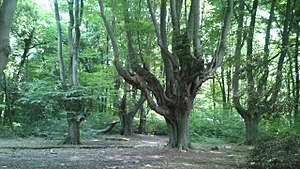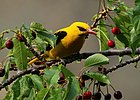Kottenforst-Waldville
|
EU bird sanctuary "Kottenforst-Waldville"
|
||
|
Head beeches in the Kottenforst |
||
| location | Bonn , Rhein-Sieg-Kreis , North Rhine-Westphalia , Germany | |
| Identifier | DE-5308-401 | |
| WDPA ID | 555537641 | |
| Natura 2000 ID | DE-5308-401 | |
| Bird sanctuary | 35.853 km² | |
| Geographical location | 50 ° 40 ' N , 7 ° 3' E | |
|
|
||
| Setup date | 2004 | |
| administration | Regional Council Cologne | |
| particularities | five sub-areas | |
The Kottenforst-Waldville area is a European bird sanctuary (protected area identifier DE-5308-401) in the south of the German state of North Rhine-Westphalia, which was designated by the Cologne Regional Council in 2004 .
The Birds Directive of the European Union serves to preserve the wild bird species native to the territory of its member states and to regulate the protection, management and regulation of these birds, their eggs and habitats .
location
The five sub-areas of the approximately 36 square kilometers large bird sanctuary "Kottenforst-Waldville" are located in the city of Bonn and the Rhein-Sieg district . They extend on the almost flat main terrace of the Rhine, southeast and northwest of the federal motorway 565 , between Heimerzheim - the largest town in the Swisttal municipality - in the northwest, Bad Godesberg in the northeast and the Wachtberg municipality in the southeast.
description
The EU bird sanctuary "Kottenforst-Waldville" represents one of the largest contiguous forest complexes in the natural area with a nationwide significant middle-aged woodpecker population . It is described as "an extensive forest area with extensive oak-hornbeam forests, near-natural mature wood stocks, small mostly dry summer ponds (so-called" maars "), near-natural springs , very steep valleys, alder alluvial forests and spring swamps".
Habitat classes
| N06 - inland waters, standing and flowing | 3% | |||
| N09 - dry grassland, steppes | 1 % | |||
| N10 - Moist and mesophilic grassland | 2% | |||
| N16 - deciduous forest | 63% | |||
| N19 - mixed forest | 6% | |||
| N20 - artificial forests | 25% | |||
Habitat types
The following habitat types are described in the "Kottenforst-Waldville" bird sanctuary:
- 3150 - Natural eutrophic lakes with a vegetation of great spawn or hydrocharition
- 6510 - Lean, lowland hay meadows
- 9110 - Hainsimsen-beech forest (Luzulo-Fagetum)
- 9130 - Woodruff beech forest
- 9160 - Subatlantic or central European pedunculate oak forest or chickweed oak-hornbeam forest (Carpinion betuli)
- 91E0 - floodplain forests with black alder and common ash
Protection purpose
The main protection purpose is the preservation and development of the oak-hornbeam, beech and alder-ash forests through near-natural forest management, the preservation and development of appropriate old and dead wood, and the protection of natural streams, spring swamps, ponds and "maars".
The area-related conservation objectives and conservation measures are described differently depending on the species .
Breeding birds
Gray woodpecker
Preservation and development of extensive, habitat-typical deciduous and mixed forests (especially beech forests) with high proportions of old and dead wood of up to ten trees per hectare, avoidance of fragmentation and islanding of populated forest areas, preservation and development of sunny clearings, forest edges, light forest structures and small structures (stumps, dead wood) as well as grassland as food areas, the improvement of the food supply (e.g. reduced fertilization, no pesticides), the maintenance of cave trees and the requirement for a permanent supply of suitable breeding trees (especially> 100-year-old beeches, trees with Damaged areas) as well as the avoidance of disturbances at the breeding sites from March to July
Middle woodpecker
Preservation and development of extensive, habitat-typical deciduous and mixed forests as well as hardwood meadows with high proportions of old and dead wood, increasing the proportion of oak forests, avoiding the fragmentation and islanding of suitable forest areas, improving the food supply, maintaining cave trees and promoting a permanent supply of suitable ones Breeding trees as well as avoiding disturbance to the breeding grounds from March to June
nightingale
Preservation and development of mixed deciduous forests and woodlands rich in undergrowth as well as of dense bushes on dams, embankments, ditches and in parks, the preservation and development of habitat structures rich in food and cover (especially dense herbaceous vegetation, high perennial thickets, dense undergrowth), the improvement of the Water balance to stabilize a water level typical of the habitat in wet and alluvial forests and wetlands as well as the improvement of the food supply in the vicinity of the breeding grounds
oriole
Preservation and development of habitat-typical softwood and hardwood alluvial forests, quarry forests as well as light, moist mixed deciduous forests with high proportions of old wood, the preservation and development of moist field trees, parks with high old trees, the improvement of the water balance to stabilize a habitat-typical water level in moist and riparian forests Improvement of the food supply in the vicinity of the breeding grounds (no pesticides)
Red kite
Preservation and development of forest areas with sparse old wood stocks as well as open, structurally rich cultural landscapes, the avoidance of fragmentation and islanding of populated habitats, the preservation and development of suitable food areas (especially grassland and arable land, fringes, leaving stubble fallow), the preservation of Horst trees with a low-disturbance environment, the avoidance of disturbances at the breeding grounds from April to July, the defusing or protection of dangerous electricity pylons and overhead lines as well as the reduction of losses due to secondary poisoning (poison bait)
Black woodpecker
Preservation and development of habitat-typical deciduous and mixed forests (especially beech forests) with high proportions of old and dead wood (up to ten trees per hectare), the avoidance of the fragmentation of the populated forest areas, the preservation and development of sunny clearings, forest edges, light forest structures and Small structures (stumps, dead wood) as food areas, the improvement of the food supply, the maintenance of cave trees and the promotion of a permanent supply of suitable breeding trees (especially> 120-year-old beeches) and the avoidance of disturbances in the breeding grounds from March to June
Black stork
Preservation and development of large-scale, poorly disturbed, structurally rich deciduous and mixed forests with a high proportion of old wood, the avoidance of the fragmentation of suitable forest areas, the preservation and development of near-natural streams, wet meadows, wet areas, swamps, forest ponds as food areas, the improvement of the water balance to stabilize a high groundwater level in the area of feeding waters, the preservation of the nest trees with a low-disturbance environment, the establishment of nest protection zones with a radius of at least 200 meters around the nest, the avoidance of disturbances in the breeding grounds and feeding areas (March to August), the control of recreational use in large-scale surroundings the breeding occurrence as well as the defusing or securing of dangerous electricity pylons and overhead lines
Honey buzzard
Preservation and development of deciduous and mixed deciduous forests with sparse old wood stocks in structurally rich, semi-open cultivated landscapes, the preservation and development of clearings and grassland areas, structurally rich forest edges and fringes as food areas with a rich supply of wasps, the improvement of the food supply, the preservation of the eyrie trees with one low-disturbance environment as well as avoiding disturbances at the breeding grounds from May to August
Migratory birds and winter guests
kingfisher

Preservation and development of dynamic river systems with flood zones, impact slopes, steep banks, the avoidance of the fragmentation of the populated habitats, the preservation and promotion of a permanent offer of natural nesting places, the careful water maintenance taking into account the demands of the species, the reduction of nutrients, pollutants and Sediment input in the area of the food waters as well as the avoidance of disturbances at the breeding sites from March to September
Connection with other protected areas
With the bird sanctuary "Kottenforst-Waldville", the following contiguous protected areas (selection) are designated:
See also
Web links
- The protected area at www.protectedplanet.net (English)
- The protected area at the Federal Agency for Nature Conservation
- The protected area at the State Office for Nature, Environment and Consumer Protection in North Rhine-Westphalia
Individual evidence
- ↑ Article 1 of the current Birds Directive
- ↑ Map of the protected area at www.protectedplanet.net, accessed on May 5, 2020. (English)
- ↑ Description of the bird sanctuary at the State Office for Nature, Environment and Consumer Protection North Rhine-Westphalia , accessed on May 11, 2020.





